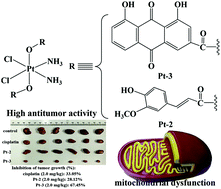Complexes of oxoplatin with rhein and ferulic acid ligands as platinum(iv) prodrugs with high anti-tumor activity†
Abstract
We herein designed two new PtIV prodrugs of oxoplatin (cis,cis,cis-[PtCl2(NH3)2(OH)2]), [PtIVCl2(NH3)2(O2C-FA)2] (Pt-2) and [PtIVCl2(NH3)2(O2C-RH)2] (Pt-3), by conjugating with ferulic acid (FA-COOH) and rhein (RH-COOH) which have well-known biological activities. Three other Pt(IV) complexes of [PtIVCl2(NH3)2(O2C-BA)2] (Pt-1), [PtIVCl2(NH3)2(O2C-CA)2] (Pt-4) and [PtIVCl2(NH3)2(O2C-TCA)2] (Pt-5) (where BA-COOH = benzoic acid, CA-COOH = crotonic acid and TCA-COOH = trans-cinnamic acid) were also prepared for the comparative study. Like most PtIV prodrug complexes, the cytotoxicity of Pt-3 containing the biologically active rhein (RH-COOH) ligand against lung carcinoma (A549 and A549/DDP) cells was higher than those of Pt-1, Pt-2, Pt-4, cisplatin and Pt-5. Moreover, the cytotoxicity of Pt-3 in HL-7702 normal cells was lower than those of PtIV derivatives bearing BA-COOH, FA-COOH, TCA-COOH and CA-COOH ligands. The highly efficacious Pt-2 and Pt-3 were found to accumulate strongly in the A549/DDP cells, with the prodrug Pt-3 showing highest levels of penetration into the mitochondria. The prodrug Pt-3 effectively entered the A549/DDP cells and caused mitochondrial damage, significantly greater than Pt-2. In addition, the prodrug Pt-3 exhibited higher antitumor efficacy (inhibition rates (IR) = 67.45%) than Pt-2 (28.12%) and cisplatin (33.05%) in the A549/DDP xenograft mouse model. Thus, the prodrug Pt-3 containing the rhein (RH-COOH) ligand is a promising candidate drug targeting the mitochondria.



 Please wait while we load your content...
Please wait while we load your content...